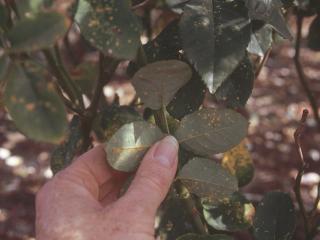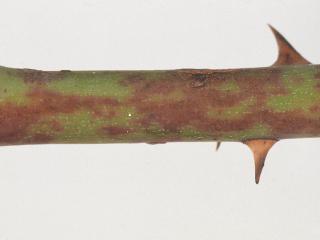Rust
Most rusts are host-specific. The fungus Phragmidium mucronatum that causes rust on roses does not infect any other plants.
In spring and early summer, orange powdery pustules develop on the undersides of leaves. Upper leaf surfaces become speckled yellow. These leaves drop prematurely. In late summer, black or brown spore masses appear with the orange pustules — these are the teliospores that can overwinter. The fungus spreads rapidly and can cause severe defoliation. The spores are spread by wind.
To control rose rust remove and destroy diseased material. When new growth occurs, spray bushes with, mancozeb, myclobutanil or triforine. An organic spray for rust is lime sulphur or bicarbonate of soda.
Anthracnose
The fungus Sphaceloma rosarum causes anthracnose, which is sometimes confused with black spot on rose leaves. The differences are that anthracnose spots are smaller and initially have sharply defined margins. As the spots enlarge, the centres become ash grey and drop away, leaving the black margins intact. The leaves become red or yellow, and may drop prematurely, but not to the same degree as with black spot.
To control anthracnose, remove and destroy diseased material. Spray bushes with mancozeb or triforine.
Cane canker
Apart from Botrytis, two of the commonest fungi to cause cane canker are Coniothyrium and Botryosphaeria species. These diseases are more commonly seen on plants stressed through poor management practices such as inadequate nutrition or irrigation.
Water-borne spores enter mainly through pruning wounds or other injuries. The disease can affect any part of the stem, initially producing yellow or red spots on the bark. These enlarge into brown cankers with dark margins, and the bark cracks and becomes sunken. Tiny black fruiting structures are sometimes seen. Canker can encircle the stem or travel down it, killing the plant.
To treat canker, prune stems back to healthy buds and destroy diseased material. After pruning apply mancozeb to protect wounds from infection.


